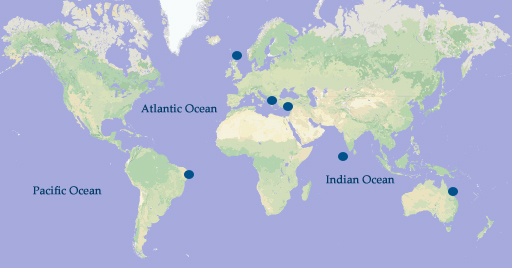Sampling Plan And Sample Analysis
Introduction
The search for ecosystems of reference is thus a key point for the definition of any classification system. In this task, the project aims to analyze the characteristics of the phytoplankton corporations in transitional ecosystems of reference that are present in diverse Eco-Regions, in the search for common models of distribution that make it possible to define quality standards (i.e. optimal conditions) that can also be applied to the Mediterranean area and the North Atlantic, in which it is not possible to observe ecosystems of reference but for which the conditions of reference can be assumed to be similar to those of ecosystems with low human impact.

Map of the Sampled Areas
This activity will be developed by means of a series of quantitative pilot studies designed to analyze the characteristics of the size/abundance distributions among the phytoplankton corporations.
This activity aims to quantify the degree of invariance / uncertainty of structural phytoplankton properties to natural source of variability and to evaluate the accurancy of general models of variation of the size-abundance distributions linked exclusively to the climatic variability, geomorphology and hydrodynamics of the sites under study.
The objective of studies is to proceed with the methodological standardization and certification of the ecological descriptors of the state of health of aquatic ecosystems based on the analysis of the dimensional structure of the phytoplankton communities.
These studies will be carried out in lagoon ecosystems that may be considered of reference, and that is practically immune to significant human pressure, in the following Eco-Regions:
- the North Atlantic area (Scotland);
- the Mediterranean area (Greece, Turkey);
- the South Atlanctic area (Brazil);
- the Indo-Pacific area (Maldives);
- the Western Pacific area (Australia).
Sampling Scheme
The experimental activity will be conducted in transitional ecosystem for each eco-region included in the project, with at least three ecosystems and three experimental stations per ecosystem in each type. The ecosystems identified are classified in relation to their type, according to Roff and Taylor (2000). In accordance with this approach, the transitional ecosystems are classifiable into n° types, identified on the basis of the granulometry of the sediments and the presence and type of vegetation. For each ecosystem considered, a maximum of three categories of habitat are selected and in each of them a sampling point is specified.
Overall Sampling Scheme

Realized Sampling Campaign

(*) In general is possible that two different sampling areas refer to the same habitat type.
Sampling scheme. *Habitat-type classification scheme based on sediment granulometry and the presence and type of vegetation according to Roff and Taylor (2000).
In accordance with the indications of the European Water Framework Directive, WFD 60/2000/EC, the classification of the ecological status of the aquatic ecosystems is based on a comparison between the conditions of each single ecosystem and the so-called “ecosystems of reference”, which have never previously been exposed to pressures as a result of human activity or have been exposed to negligible pressure.
Analysis of the common patterns of taxonomic distribution and size structure of the phytoplankton corporations were carried out in lagoon ecosystems that may be considered of reference.
The field experimental activity was conducted in transitional ecosystem for each eco-region included in the following Eco-Regions: the North Atlantic area (Scotland); the Mediterranean area (Greece, Turkey); the South Atlantic area (Brazil); the Indo-Pacific area (Maldives); the Western Pacific area (Australia).
The field activity was conducted using an experimental design already successfully tested in a series of transitional environments in the Mediterranean eco-region.
The samples of phytoplankton gathered were analysed in the laboratory to determine the taxonomic parameters and non-taxonomic parameters. Phytoplankton analysis was carried out using an inverted microscope (Nikon T300E) following Utermöhl’s method at 400x magnification. Phytoplankton counts and morphometric measurements were performed semi-automatically using a video-interactive image analysis system (L.U.C.I.A Version 4.71, Laboratory Imaging) connected to the microscope. A geometric shape identified with a numerical code was attributed to each taxon. For each sample, at least 400 organisms were counted. Taxonomic identification was carried out using several references.
Staff
- E. Stanca, Temporary researcher fellow
- M. Cellamare, Temporary researcher fellow
- A. Fiocca, Technician on term/ Temporary researcher fellow
- L. Roselli, Temporary researcher fellow
- J. Sampaio, PhD Student
- Prof. A.Basset
Scientific, technical and logistic’s support was be done by local experts and local fishermen, during field activities:
- Prof. Josè Luiz Attayde, Professor of Ecology, Universidade Federal do Rio Grande do Norte (Brazil)
- Davide Seveso and Dr. Paolo Galli, University of Milano-Bicocca Dept. Biotechnology & Biosciences (Italy), MaRHE Centre, Magoodhoo (Maldives)
- Stamatis Ghinis and Savina Gioni, Region of Ionian Islands, Corfu (Greece)